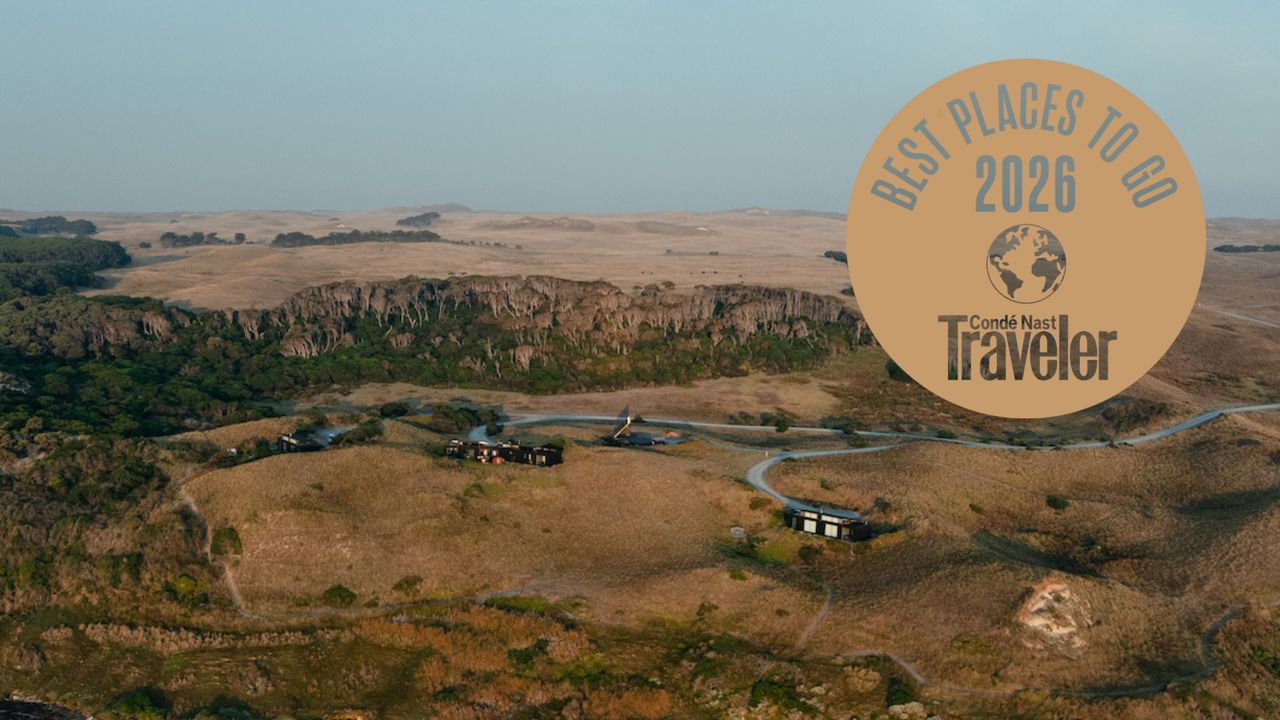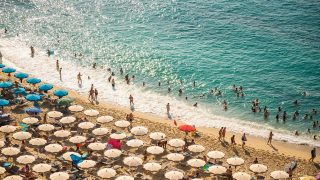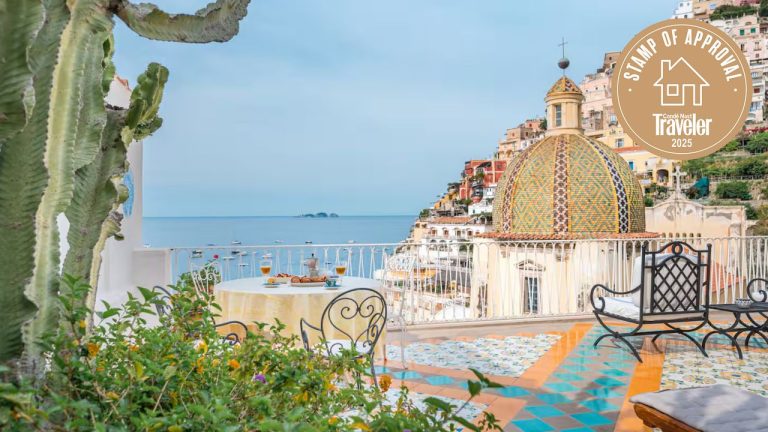For sustainable retreats, sacred sites, and a South Pacific archipelago cautiously reopening to the world.

Oscar Sloane/Kittawa Retreat
All products and listings featured on Condé Nast Traveler are independently selected by our editors. However, we may receive compensation from retailers and/or from purchases of products through these links.
The best places to go in Australia, New Zealand, and the Pacific Islands in 2026 may surprise you, but in compiling this list, we couldn’t be more excited about the possibilities they present for travel in the year ahead. While the natural beauty of Oceania still stuns—from the volcanic heart of New Zealand to the reef-fringed Pacific—2026 is proving that the region’s most compelling stories are increasingly urban, local, and unexpected. It all makes for fantastic travel-planning fodder.
To give you just a taste of what lies ahead: We cover how Australia’s cities are stepping into a new era, including how Parramatta is becoming Sydney’s “second city,” how Adelaide is riding the wave of a hotel boom, and how Perth is transforming into a cultural playground. Darwin, meanwhile, long a gateway to the wild Northern Territory, is humming with a fresh kind of creativity, driven by artists, makers, and a new generation of storytellers. It’s not just the capitals either: Smaller towns like Port Stephens are evolving into smart-leisure destinations, and King Island, an island off Tasmania—is teeing up its own tourism moment, with its world-class golf course finally matched by new hotel rooms. In the Pacific, New Caledonia is rolling out a warm welcome as it reopens to the world, complete with a new-look museum and revitalized hospitality scene. Meanwhile, over in New Zealand, Queenstown, the adventure capital of the Southern Hemisphere, is kicking off 2026 with top-notch luxury and wellness offerings to pair with its signature adrenaline. It’s more than enough to inspire your next big trip—or three.
Whichever you choose, we can’t wait to meet you there. Read on for the best places to go in Oceania in 2026. —Chloe Sachdev
This is part of our global guide to the Best Places to Go in 2026—find more travel inspiration here.
The Best Places to Go in Oceania in 2026
Adelaide, Australia
Go for: A supersized food market, buzzing hotels, and The Ghan’s most decadent chapter yet

The Ghan, Australia’s transcontinental luxury train (pictured above), is adding two opulent new suites in 2026 which will make these scenic journeys even dreamier.
The Ghan
Long admired for its Barossa reds, farm-to-table bistros, and charming cellar doors, Adelaide has always been a quiet achiever. Now the South Australian capital is gearing up for a blockbuster 2026. Leading the charge is the $500 million (US$330 million) Market Square development, set to open in late 2026. The vertical precinct, a blend of steel, glass, and nostalgic red brick, will double the footprint of the city’s beloved Central Market—already a hub of multigenerational food vendors, including one of the largest fresh produce markets in the Southern Hemisphere—and introduce rooftop terraces, residences, and the first Australian outpost of Treehouse Hotel, known for its playful, design-forward interiors.
Keeping the ball rolling, the city’s hotel scene is expanding fast in late 2026, with 238-room Little National (whose rooftop bar is already drawing buzz) and Crystalbrook Sam, a 13-story addition from the fast-growing brand famed for lifestyle hotels with a focus on wellness and buzzy dining, which will open a few streets from Market Square.
The biggest news comes in April, when The Ghan, Australia’s iconic transcontinental train that connects Adelaide with the Northern Territory, debuts two sleek new suites, the Australis and Aurora, complete with private dining, butler service, and a top-shelf wine list. Off the coast, Kangaroo Island’s The Cliffs, a destination golf course built by in-demand designer Darius Oliver (the same designer behind Cape Wickham, perhaps Australia’s top golf course), will open for preview play in January. And with United Airlines launching the first-ever nonstop from the US to South Australia (San Francisco to Adelaide) in December 2025, it’s never been easier to experience Adelaide’s charm. —Jo Stewart
Darwin, Australia
Go for: a packed cultural calendar and a revitalized waterfront

In Darwin, the far-flung capital of the Northern Territory, a packed calendar of festivals, fairs, and even a rodeo will highlight the city’s rich Indigenous culture and thriving art scenes.
National Aboriginal and Torres Strait Islander Art Awards
On Australia’s tropical northern edge, Darwin, the capital city of the Northern Territory, has always had creative energy—its cultural pulse evident in a packed calendar of festivals that define the dry season: June 21, the summer solstice, will see the start of the National Aboriginal and Torres Strait Islander Art Awards, which will run until January 2027. July’s highlight will be the Top End Bull Spectacular, for which Australia’s best bull riders take over the Darwin Waterfront. And a blockbuster August will feature the Darwin Aboriginal Art Fair with more than 70 remote art centers represented, which will include a fashion show and awards; the National Indigenous Music Awards; and the citywide Darwin Festival. The calendar never slows. Add in the Darwin Street Art Festival and year-round weekend markets at Parap, Rapid Creek, and Nightcliff, and the city feels truly nonstop.
In the last couple of years, this energy has fueled the creation of stand-alone galleries. Laundry Gallery, a First Nations–led creative hub in a converted 1970s laundromat, exhibits and celebrates Indigenous art and stories, while Outstation Gallery’s new waterfront home pairs contemporary First Nations art with sweeping harbor views.
The blockbuster news for 2026 is the opening in October of the Larrakia Cultural Centre—a landmark venue and permanent space to experience the city through the lens of its traditional owners—at the waterfront precinct. Designed to celebrate and share Larrakia culture, it will invite visitors into stories, art, and traditions that bring Country into sharp focus. —Nina Fitzgerald
King Island, Australia
Go For: world class golfing, luxury hideaways, and isolation on the edge of the Southern Ocean
Tasmania’s windswept King Island continues to beckon travelers with the expansion of the Kittawa Lodge (pictured above) and Ocean Dunes golf course.
Kittawa Lodge/Bowerbird Collective
Remote, rugged, and oddly overlooked, King Island—an island off an island—sits in the middle of the wild Bass Strait like a sentinel of the Southern Ocean. Battered by wind and weather, it’s long been something of an enigma: easy enough to reach in under an hour, with direct flights from Melbourne and mainland Tasmania, yet with remarkably few places to stay. And there’s plenty of reason to go, thanks to a frothy coastline, rich dairy heritage, and more wallabies than people—not to mention three spectacular coastal golf courses, two of which are regularly ranked among the world’s best.
For years King Island felt like a destination hiding in plain sight. The turning point came with the arrival in 2019 of Kittawa Lodge, a couple of smart, one-bedroom luxury hideaways on the edge of salt-licked cliffs. In early 2025, Kittawa expanded its footprint with a new, two-bedroom retreat that carries the same signature traits—fireplaces, deep-soaking tubs facing the thrashing ocean, and floor-to-ceiling windows that routinely draw curious wallabies’ noses to the glass—but with a few elevated extras, including an outdoor magnesium hot tub, a top-shelf wine cellar, and more space to settle in. The island’s even bigger news comes in late 2026: Ocean Dunes golf course, ranked one of the best public courses in the Asia-Pacific, will unveil its new restaurant, clubhouse, and on-course hotel rooms—64 sleek, glass-fronted rooms and suites just off the first and ninth fairways that will have clean-lined box windows framing uninterrupted ocean views. Stretching along the island’s wild western edge, the course is a sea-sprayed, wind-lashed affair—best followed by a dram of Tasmanian whisky and a plate of local cheese. Don’t miss a round at Cape Wickham to the north, or a tasting at King Island Dairy, one of Australia’s most iconic producers, which was recently returned to Australian hands. By 2026, visitors to the factory can look forward to a wider range of experiences. The cheese store will expand, adding a wine bar featuring premium Tasmanian wine vintages. Plus, King Island Dairy farms will open its gates for a new “farm experience”; guests will be able to witness the cutting-edge automated milking system in action. Once complete, it’s expected to be among the world’s largest for a pasture-based, free-range dairy herd—offering a rare, behind-the-scenes paddock-to-plate experience. —Chloe Sachdev
Margaret River, Australia
Go for: vineyard hopping, epic swells, and food festivals

The World Surf League Margaret River Pro takes place from April 17-27, as the second stop on the WSL’s Championship Tour.
World Surf League/Aaron Hughes

After surfing—or watching the pros surf—locals head to the region’s storied wineries, which continue to expand their footprint.
World Surf League/Aaron Hughes
Margaret River is a name that conjures visions of rugged coastal landscapes, big swells, and rolling vineyards. Here in Wadandi country, home to the “saltwater people” for over 40,000 years, you choose your own adventure: Hike the 84-mile Cape to Cape Track between Cape Naturaliste in the north and Cape Leeuwin in the south, dive into immersive cultural experiences, or engage with a food and wine scene that has deep roots.
The international surf spotlight shines on the WSL Margaret River Pro 2026 (April 17–27), which will be the second stop of the World Surf League’s Championship Tour, which is celebrating its 50th anniversary. Then a local roster of food and wine talent lights up winter with the 10th edition of the Cabin Fever festival (July 17–26) before Pair’d, a wine and food celebration, returns in November 2026 for its third year in a row (in 2025, headliners included Francis Mallmann, David Pynt, and Josh Niland, and 2026 is likely to build on its impressive beginnings).
Opening in early 2026, the team behind Margaret River’s storied winery Vasse Felix will debut two new experiences. First, there will be a sleek tasting salon for Idée Fixe, the winery’s sparkling offshoot dedicated to Blanc de Blancs, a style made entirely from Chardonnay, in the traditional Champagne method. While Idée Fixe, just south of Margaret River town, has quietly been producing for several years, this will be its first stand-alone space, where it will offer immersive tastings and a behind-the-scenes look into the craft of méthode traditionnelle winemaking. It’s a natural evolution in a region widely considered Australia’s top Chardonnay producer. Second, a coastal-inspired bistro will open with sweeping views of the vineyard.
Late in 2026, Dunsborough, in the region’s north, will welcome South West House, a boutique hotel that will bring a new layer of smart Australian luxury to the region. Throughout the 54 guest rooms and adjoining wellness and hospitality amenities, there’s a blend of raw industrialism and natural materials. Meanwhile, a transformative restoration of The Margaret River Hotel, a 90-year-old icon, sees Arts and Crafts–era style put to work over 27 designer rooms and will open in mid-2026, as will the bar and dining room (much to the relief of locals), whose hyperlocal menu now champions Western Australian produce with a wine cellar to match. —Max Brearley
New Caledonia
Go for: an island paradise quietly rebuilding—and warmly welcoming visitors

New Caledonia is emerging from a period of political turmoil and welcoming back travelers, who can experience its stunning lagoons and support recovery without the crowds of other Pacific island destinations.
Getty
A paradisiacal South Pacific archipelago fringed by a UNESCO-listed lagoon, New Caledonia has long delivered postcard fantasies. However, in 2024, widespread civil unrest brought tourism to a standstill: International flights were grounded for six months, and visitor numbers remained flat. Now, following a historic July 2025 agreement aimed at resolving the territory’s political status, the islands are slowly and cautiously reopening to the world.
While international arrivals are still lagging, 2026 presents a rare window to experience New Caledonia without the usual crowds—and to support local operators who are rebuilding from the ground up. Among them: Toutazimut, a female-run ecotourism outfit known for off-grid adventure tours into the wild, unpolished corners of the archipelago. In the capital, Nouméa, Elysium is leading the city’s culinary resurgence with sharply executed island-French dishes. At the same time, local brand Botanik bottles the island with its line of wild-crafted perfumes and plant-based skin care.
Rising beside the reef-protected blonde beach of Anse Vata, breezy apartment hotel Aqualuna is set to open its doors in 2026 and will offer pared-back coastal living with views across the lagoon. The same year will see the long-awaited reopening of the Museum of New Caledonia, which houses one of the world’s most significant collections of Indigenous Kanak art and includes works from West Papua, Eastern Polynesia, Vanuatu, and more. The museum’s relaunch signals more than just the revival of tourism for New Caledonia; it marks a new chapter as a cultural anchor for the region. —Sarah Reid
Parramatta in Sydney, Australia
Go for: a blockbuster museum, bold architecture, and a global dining scene in Sydney’s geographic heart

Sydney’s hip second center is getting its time in the sun with the arrival of Australia’s largest museum and an enviable restaurant scene.
Shutterstock
Long overshadowed by Sydney’s glittering harbor, Western Sydney is emerging as a dynamic cultural engine—diverse, ambitious, and buzzing. In part this is thanks to the opening in October 2026 of Powerhouse Parramatta, Australia’s largest museum, which is the main driving force catapulting Sydney’s second center into the spotlight. With the original campus at Ultimo closed for renovations until late 2027, Powerhouse Parramatta’s 194,000 square feet of exhibition space will be the only destination to explore the museum’s one-of-a-kind collections that cover design, technology, science, and the arts, and include everything from fashion and jewelry to steam locomotives. Food is also a focus, which makes sense given the area’s multicultural makeup. Find everything from a family-run Cantonese restaurant to hand-pulled noodle joints; one suburb over is Harris Park, known as Little India, packed with more than 20 Indian restaurants. The museum will be putting serious muscle into a meet-the-makers food program, highlighting local producers of Korean kimchi, Vietnamese banh mi, and Lebanese sweets, as well as tapping much-loved Australian chef Kylie Kwong as an ambassador to steer the program (there will also be supper clubs popping up in local restaurants). The 200-seat restaurant and 100-seat alfresco terrace overlooking the river will also showcase a snapshot of this blockbuster food-focused program. The striking building set on a stretch of the Parramatta River will be an attraction in itself owing to its over 250-foot-high white steel exoskeleton designed by Moreau Kusunoki, also in charge of revamping Paris’s Centre Pompidou.
Add in two planned hotels—the edgy QT Parramatta and the high-rise InterContinental Parramatta (exact opening dates have yet to be announced)—as well as the new Western Sydney International airport, which will open in the second half of 2026 and is expected to become Sydney’s primary airport, and Parramatta is fast moving beyond day trip territory. —Ute Junker
Perth, Australia
Go for: revamped coastal and cultural hubs

Perth continues to grow as Western Australia’s cultural hub, anchored by museums like the Boola Bardip (pictured above).
WA Museum Boola Bardip
Long overlooked in favor of Australia’s east-coast capitals, Perth, one of the world’s most isolated cities, is coming into its own. Licked by the Indian Ocean, Western Australia’s sun-soaked capital is known for its electric-blue beaches and laid-back lifestyle. Opening in late 2026, Perth’s first man-made ocean pool will be a game changer for this area where the surf is famously rough and shark-prone. Meanwhile, the city’s vibrant cultural scene is evolving fast and ready to take center stage.
The Perth Cultural Centre is undergoing a major transformation and is primed to reopen in 2026 with a fresh new look (the exact opening date has yet to be announced). Anchored by a central plaza, the precinct is being reimagined not just as a place to visit but hang out—shaded, walkable, and alive with public art, bars, cafés, and after-dark projections. Joining it is a state-of-the-art campus for the Western Australian Academy of Performing Arts, featuring world-class rehearsal and performance spaces. While you’re there, catch the final days of WA Museum Boola Bardip’s “Terracotta Warriors” exhibition, running until February 26.
For a stylish stay, check in to Garde, a hotel within the historic mid-19th-century Fremantle Police Headquarters. Opened in September 2025, the hotel offers 83 rooms and suites, and houses Anglesea, a modern Australian restaurant already creating serious buzz. Over in East Victoria Park, Baillie Hill—a charming new cluster of restaurants, artist studios, and a farmers market—opens in December 2025.
On the coast, Bert’s, a retro-chic revival of a 1950s beach kiosk, opened on City Beach in October 2025, just in time for summer. Nearby, Perth’s first ocean pool is set to make a splash in 2026, and if rumors are to be believed, the city could be home to the Southern Hemisphere’s largest wave pool by 2027. —Sarah Reid
Port Stephens, Australia
Go for: family holidays with endless beaches and elevated new stays

Beekeeping at B Farm in Port Stephens, Australia is just one of the estate’s many sustainable offerings.
B.Farm

Chic Port Stephens hotels, like B Farm, are bringing new culinary offerings to the region, as well as cooking classes for guests.
B.Farm
Port Stephens still knows how to do a classic Aussie holiday: barefoot days, dolphin sightings, and beaches that stretch on for miles. But nowadays, alongside the family caravan parks and takeaway joints, there is a crop of smarter places to bed down. Just two hours north of Sydney, this coastal favorite is now also a place where you can find a decent pinot or a boutique stay.
Getting the buzz started were two openings in 2025. First it was The Ambers, a chic private retreat sleeping just 22 people; it’s owned by the same local family behind photogenic Salt at Shoal Bay holiday rentals. It was closely followed by the ocean-view Marina Resort, which will be completed in January and is perfect for travelers who want to be close to the main port (D’Albora Marina) without sacrificing a resort-style stay. In February 2026, B Farm, which takes a homesteading approach similar to South Africa’s famous Babylonstoren, will be rolling out a range of accommodations, including tiny houses, glamping suites with plunge pools, and cabins with outdoor baths, and activities like sheep feeding, pony grooming, cooking classes, perfume workshops, and soapmaking.
The area remains a major pull, on account of the World Heritage–listed rainforest trails of the Barrington Tops National Park, camel rides on Stockton Beach, and encounters with Australia’s furry mascots at the Port Stephens Koala Sanctuary. Adding to the appeal, the Newcastle Art Gallery—about a 30-minute drive from Port Stephens—is set to fully reopen in February 2026 following a major expansion that will double its size, making it the largest art gallery outside Sydney. With international flights now landing at the nearby Newcastle Airport, a gateway to Port Stephens and the Hunter Valley wine region, the area is officially booming. —Ute Junker
Queenstown, New Zealand
Go for: rugged adventure and high thread count luxury

Lake Wakatipu provides the backdrop to Queenstown, New Zealand, which will welcome several new hotels and ski resorts in 2026.
The Design Group New Zealand
Queenstown has long drawn travelers with its snow-dusted peaks, mirrored lakes, and golden valleys; it’s a landscape that feels both raw and cinematic. But now the blockbuster alpine town known as the adventure capital of the Southern Hemisphere is entering a new phase in which wellness and luxury meet its jolt-to-the-arm adrenaline.
Roki Collection Queenstown, which arrived in September 2025, raised the bar with 15 ultra-luxurious suites and high-spend services, just close enough to the action of town. Opening in late 2026, Waimarino Luxury Lodge will introduce 20 oversized villas to secluded Bob’s Cove, blending modern, raw concrete architecture with luxury trimmings like l electric boats, fine dining, and spa rituals. In December 2025, Coronet Ridge Resort will reemerge as a 40-room alpine retreat near the slopes. Meanwhile, QT Queenstown is expanding its footprint by taking over the 152-room Rydges Lakeside Queenstown hotel on Lake Wakatipu, with new rooms opening in stages from the first half of 2026.
Adventure is still the heartbeat. The 2025 expansion of Soho Basin added just over half a square mile of advanced terrain to Cardrona Alpine Resort. Set to open in early 2026, the new Kawarau Gorge bike trail will connect the vineyards of Gibbston Valley with Cromwell in one sweeping ride. Later in the year Skyline Queenstown’s gondola will launch a redesigned summit platform and refreshed restaurant with panoramic views. Wellness is getting a glow-up too. The Bathhouse Queenstown will debut its winning formula—vitality pools, cold plunges, Finnish and infrared saunas, scented steam rooms—in the new Upper Village precinct in December 2025, while the sleek Bathe by Aluume thermal pools on the shores of Lake Wakatipu are soon to be joined by New Zealand’s first floating sauna in mid 2026.
Beyond the upgrades, Queenstown is thinking long-term, aiming to become a carbon-zero visitor economy by 2030, a regenerative vision that looks to give back more than it takes. For travelers it’s a place that promises beauty, adrenaline, and luxury with purpose. —Johanna Thornton
Uluru, Australia
Go for: spiritual connection, epic trekking, and a desert that lights up after dark
Storied and sacred Uluru will be celebrated in 2026 with a roster of new exhibitions and light-and-sound shows like Bruce Munro’s “Field of Light” (pictured above).
Voyages Indigenous Tourism Australia
The raw beauty of the Australian outback is magnified at Uluṟu. More than just a geological wonder, the rock formation has been shaped by thousands of years of Aṉangu law, story, and ceremony, and bears a spiritual and cultural weight greater than the red dust settling at its feet. October 2025 marked the 40th anniversary of the historic hand-back of the title deeds for Uluṟu-Kata Tjuṯa National Park to its traditional owners, the Aṉangu—a milestone that set the tone for the region’s next chapter. Launching in April 2026, the Uluṟu-Kata Tjuṯa Signature Walk will link the red domes of Kata Tjuṯa with the crimson monolith of Uluṟu and offer a deeper, slower way to connect with the culture embedded in these twin sacred sites. The luxury four-night guided trek spans 33.5 miles and includes stays at purpose-built glamping camps and a new ecolodge, with Aṉangu storytellers walking alongside guests to share their deep knowledge of Country. It’s the latest in a string of innovative Red Centre experiences: from Uluṟu’s high-tech light-and-sound shows—Sunrise Journeys and Wintjiri Wiṟu—to the launch of the Ghan’s new luxury train suites, Australis and Aurora, in April 2026. Meanwhile, Bruce Munro’s Field of Light now shines brighter than ever after a 2025 refurbishment ahead of its 10th anniversary in 2026. Up the Stuart Highway in Alice Springs, Intrepid Travel’s new Indigenous-guided Larapinta Trail trek, which opened in May 2025, offers another route into the stories and landscapes that define the heart of the country. —Sarah Reid
Lancemore Lindenderry Red Hill
$$ | Australia, Red Hill, 142 Arthurs Seat Rd






